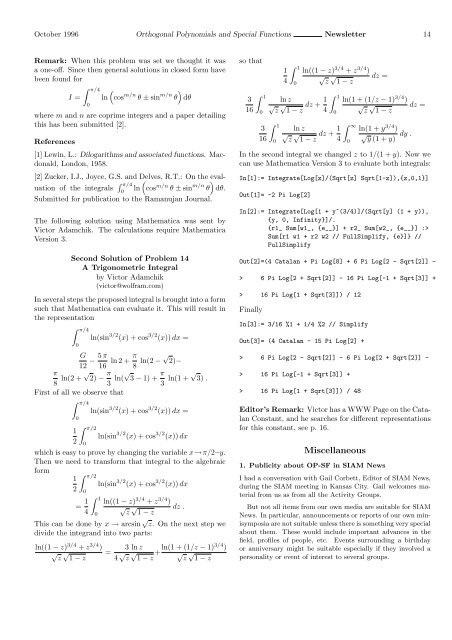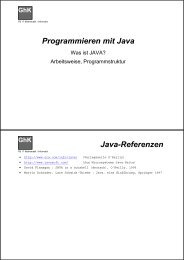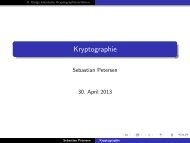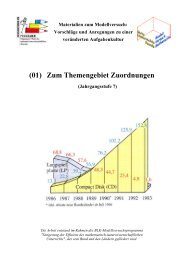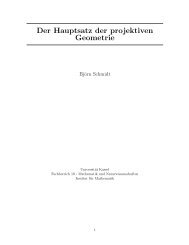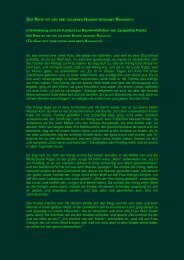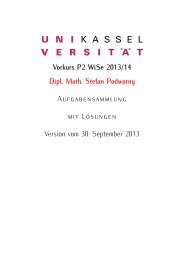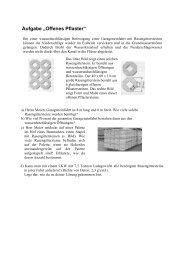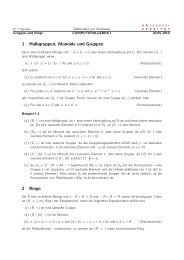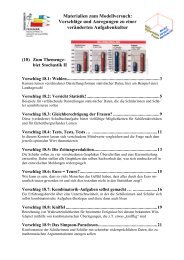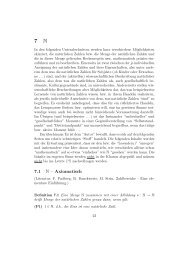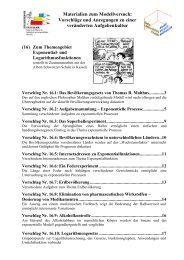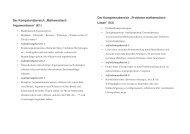Orthogonal Polynomials and Special Functions
Orthogonal Polynomials and Special Functions
Orthogonal Polynomials and Special Functions
Create successful ePaper yourself
Turn your PDF publications into a flip-book with our unique Google optimized e-Paper software.
October 1996 <strong>Orthogonal</strong> <strong>Polynomials</strong> <strong>and</strong> <strong>Special</strong> <strong>Functions</strong> Newsletter 14<br />
Remark: When this problem was set we thought it was<br />
a one-off. Since then general solutions in closed form have<br />
been found for<br />
π/4 <br />
I = ln cos m/n θ ± sin m/n <br />
θ dθ<br />
0<br />
where m <strong>and</strong> n are coprime integers <strong>and</strong> a paper detailing<br />
this has been submitted [2].<br />
References<br />
[1] Lewin, L.: Dilogarithms <strong>and</strong> associated functions. Macdonald,<br />
London, 1958.<br />
[2] Zucker, I.J., Joyce, G.S. <strong>and</strong> Delves, R.T.: On the evaluation<br />
of the integrals <br />
π/4<br />
ln cos 0<br />
m/n θ ± sin m/n <br />
θ dθ.<br />
Submitted for publication to the Ramanujan Journal.<br />
The following solution using Mathematica was sent by<br />
Victor Adamchik. The calculations require Mathematica<br />
Version 3.<br />
Second Solution of Problem 14<br />
A Trigonometric Integral<br />
by Victor Adamchik<br />
(victor@wolfram.com)<br />
In several steps the proposed integral is brought into a form<br />
such that Mathematica can evaluate it. This will result in<br />
the representation<br />
π/4<br />
ln(sin<br />
0<br />
3/2 (x) + cos 3/2 (x)) dx =<br />
G 5 π<br />
−<br />
12 16<br />
ln 2 + π<br />
8 ln(2 − √ 2)−<br />
π<br />
8 ln(2 + √ 2) − π<br />
3 ln(√3 − 1) + π<br />
3 ln(1 + √ 3) .<br />
First of all we observe that<br />
π/4<br />
ln(sin<br />
0<br />
3/2 (x) + cos 3/2 (x)) dx =<br />
π/2<br />
1<br />
ln(sin<br />
2 0<br />
3/2 (x) + cos 3/2 (x)) dx<br />
which is easy to prove by changing the variable x→π/2−y.<br />
Then we need to transform that integral to the algebraic<br />
form<br />
1<br />
2<br />
π/2<br />
ln(sin<br />
0<br />
3/2 (x) + cos 3/2 (x)) dx<br />
1<br />
ln((1 − z) 3/4 + z3/4 )<br />
√ √ dz .<br />
z 1 − z<br />
= 1<br />
4<br />
0<br />
This can be done by x → arcsin √ z. On the next step we<br />
divide the integr<strong>and</strong> into two parts:<br />
ln((1 − z) 3/4 + z 3/4 )<br />
√ z √ 1 − z<br />
=<br />
3 ln z<br />
4 √ z √ 1 − z +ln(1 + (1/z − 1)3/4 )<br />
√ √<br />
z 1 − z<br />
so that<br />
1<br />
1 ln((1 − z)<br />
4 0<br />
3/4 + z3/4 )<br />
√ √ dz =<br />
z 1 − z<br />
1<br />
3 ln z<br />
√ √ dz +<br />
16 0 z 1 − z 1<br />
1<br />
ln(1 + (1/z − 1)<br />
4 0<br />
3/4 )<br />
√ √ dz =<br />
z 1 − z<br />
1<br />
3 ln z<br />
√ √ dz +<br />
16 0 z 1 − z 1<br />
∞<br />
ln(1 + y<br />
4 0<br />
3/4 )<br />
√ dy .<br />
y (1 + y)<br />
In the second integral we changed z to 1/(1 + y). Now we<br />
can use Mathematica Version 3 to evaluate both integrals:<br />
In[1]:= Integrate[Log[z]/(Sqrt[z] Sqrt[1-z]),{z,0,1}]<br />
Out[1]= -2 Pi Log[2]<br />
In[2]:= Integrate[Log[1 + y^(3/4)]/(Sqrt[y] (1 + y)),<br />
{y, 0, Infinity}]/.<br />
{r1_ Sum[w1_, {e__}] + r2_ Sum[w2_, {e__}] :><br />
Sum[r1 w1 + r2 w2 // FullSimplify, {e}]} //<br />
FullSimplify<br />
Out[2]=(4 Catalan + Pi Log[8] + 6 Pi Log[2 - Sqrt[2]] -<br />
> 6 Pi Log[2 + Sqrt[2]] - 16 Pi Log[-1 + Sqrt[3]] +<br />
> 16 Pi Log[1 + Sqrt[3]]) / 12<br />
Finally<br />
In[3]:= 3/16 %1 + 1/4 %2 // Simplify<br />
Out[3]= (4 Catalan - 15 Pi Log[2] +<br />
> 6 Pi Log[2 - Sqrt[2]] - 6 Pi Log[2 + Sqrt[2]] -<br />
> 16 Pi Log[-1 + Sqrt[3]] +<br />
> 16 Pi Log[1 + Sqrt[3]]) / 48<br />
Editor’s Remark: Victor has a WWW Page on the Catalan<br />
Constant, <strong>and</strong> he searches for different representations<br />
for this constant, see p. 16.<br />
Miscellaneous<br />
1. Publicity about OP-SF in SIAM News<br />
I had a conversation with Gail Corbett, Editor of SIAM News,<br />
during the SIAM meeting in Kansas City. Gail welcomes material<br />
from us as from all the Activity Groups.<br />
But not all items from our own media are suitable for SIAM<br />
News. In particular, announcements or reports of our own minisymposia<br />
are not suitable unless there is something very special<br />
about them. These would include important advances in the<br />
field, profiles of people, etc. Events surrounding a birthday<br />
or anniversary might be suitable especially if they involved a<br />
personality or event of interest to several groups.


